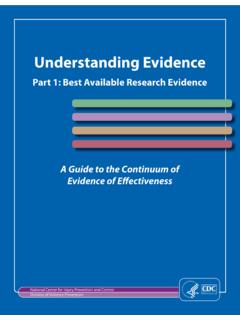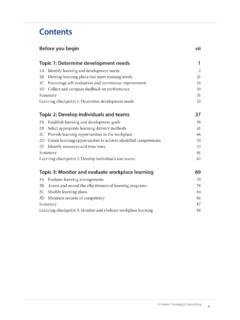Transcription of Using - AASA
1 Using Data to Improve Schools What's Working Using Data to Improve Schools: What's Working This publication was created with editorial assistance from KSA-Plus Communications in Arlington, Va. This report was produced in whole or part with funds from the Office of Educational Research and Improvement, Department of Education, under award # R215 U99. 0019. Its contents do not necessarily reflect the views or policies of the Department of Education. About AASA. The American Association of school Administrators, founded in 1865, is the professional organization for over 14,000 educational leaders across the United States and in other countries. AASA's mission is to support and develop effective school system leaders who are dedicated to the highest quality public education for all children. ii Foreword school system leaders are discovering the power of data for promoting school improvement. With recent advances in technology and the increased demand for assessing student learning, an unprecedented amount of data are available to educators.
2 school districts across America are beginning to use the tools necessary to make effective use of the data. In addition to test scores, many educators are collecting data about citizenship, character, healthy lifestyles, school climate and parental and community involvement. One superintendent reflected that We spend a lot of time on testing but not much time on what to do with the test results. As educators shift their focus from simply reporting test results to Using the data to improve instruction, data become essential ingredients in school improve- ment. Educators know that the effective use of data can measure student progress, evaluate program and instructional effectiveness, guide curriculum development and resource allocation, promote accountability and, most importantly, ensure that every child learns. Using Data to Improve Schools: What's Working is an easy-to-read guide to Using data to drive school improvement.
3 school system leaders and their staffs can learn from this book how to build a districtwide culture of inquiry that values the use of data for sound decision-making. school board members, parents and community members interested in helping improve schools will find tools for their work as well in this guide. It describes the challenges and the successes of educators from districts both large and small committed to Using data. We are sure that you will find this guide useful in your ongoing efforts to provide leadership to your schools and communities. Paul D. Houston, Executive Director American Association of school Administrators iii Using Data to Improve Schools: What's Working Acknowledgments Development Advisory Team Bill Adams John Lacy Superintendent Superintendent Salem County Vocational Technical Schools Billings R-IV school District Woodstown, Billings, Mo. Lance Alwin Peg Portscheller Superintendent Executive Director Antigo Unified school District Colorado Association of school Executives Antigo, Wis.
4 Englewood, Colo. Mary Barter Roland Smit Superintendent Superintendent Durango school District 9-R Mobridge school District Durango, Colo. Mobridge, Richard P. Fragale Linda Dawson Superintendent Project Director Central Union High school District National school Boards Foundation El Centro, Calif. Aspen Group International Castle Rock, Colo. David E. Gee Superintendent Western Suffolk BOCES. Dix Hills, iv Acknowledgments AASA Project Staff Mary F. Barter Superintendent Judy Seltz Durango school District 9-R. Associate Executive Director Durango, Colo. Constituent Relations and Services Barbara F. Erwin Geannie Wells Superintendent Director Scottsdale Unified school District 48. Center for Accountability Solutions Phoenix, Ariz. Mike Parker Richard P. Fragale Assistant Director Superintendent Center for Accountability Solutions Central Union High school District El Centro, Calif. Aleck Johnson Program Manager David E. Gee Center for Accountability Solutions Superintendent Western Suffolk BOCES.
5 Sarah Wayne Dix Hills, Program Assistant Center for Accountability Solutions Donald L. Kussmaul Superintendent East Dubuque Community Unit school AASA Executive Committee District 119. East Dubuque, Ill. Don W. Hooper President John R. Lawrence Superintendent Superintendent Fort Bend Independent school District Lincoln County R-III school District Sugar Land, Texas Troy, Mo. Bill Hill Estanislado Y. Paz President-Elect Superintendent Superintendent Deer Valley Unified school District Tucson Unified school District Phoenix, Ariz. Tucson, Ariz. Benjamin O. Canada Kay E. Royster Immediate Past President Deputy Chief Executive Officer Educational Consultant Detroit Public school District Atlanta, Ga. Detroit, Mich. v Using Data to Improve Schools: What's Working Foreword .. iii Acknowledgments .. iv Chapter 1: Why Data Matter .. 1. Chapter 2: Using Data to Make Smart Decisions .. 13. Chapter 3: Data, Public Engagement and Strategic 27.
6 Chapter 4: Strategies for Success .. 37. Appendix A: Accountability Measures .. 53. Appendix B: Working with the Media .. 54. Appendix C: Resources .. 56. Appendix D: Glossary .. 60. vi Chapter 1: Why Data Matter What goals has your school district set for the next three years? What data will help judge whether the district is meeting its goals? How are superintendents Using data they currently collect to improve student achievement over time? What additional data must be collected and why? In what ways are teachers, principals, district staff and the community involved in data collection and analysis? M any superintendents have a powerful ally on their side: data. Increasingly, superintendents are Using data to make smarter decisions, and they are getting results. Instead of responding defensively to critics, they are armed with facts and figures that tell a more complete story and help critics understand the root causes of the challenges schools face.
7 Data-driven decision-making is about gathering data to understand if a school or district is meeting its purpose and vision, says Victoria Bernhardt, author If I, as the superintendent, cannot talk about how of Data Analysis for Comprehensive Schoolwide much learning has occurred, then I'm not achieving Improvement. (See A Closer Look on page 2.) If we do what I had hoped to as superintendent. not have a target, we could make decisions that essen- Gerrita Postlewait, superintendent, tially lead to random acts of improvement.' Instead, Horry County ( ) Public Schools Bernhardt says, superintendents should strive for focused acts of improvement, which occur when schools are clear about their purpose, about what they expect students to know, and about what they expect students to be able to do. In data-driven districts, superintendents work side by side with other administrators, teachers, principals and parents to ensure all children achieve.
8 Everyone strives toward common goals. Data provide quantifiable proof, taking the emotion and rancor out of what can be tough calls for superintendents and school boards ( , dismantling a popular but ineffective program or closing a school ). Data also provide the substance for meaningful, ongoing dialogue within the educational community. For the past several years, Superintendent Gerrita Postlewait and the Horry County ( ). Public school Board have made data-driven decision-making the cornerstone of school improvement. This is now a school system that focuses on results, Postlewait says. If I, as the 1. Using Data to Improve Schools: What's Working superintendent, cannot talk about how much learning has occurred, then I'm not What is achieving what I had hoped to as superintendent. (See Getting Results on page 3.). data-driven Postlewait and other superintendents acknowledge that data were not always at decision-making?
9 The forefront of their decision-making. Until recently, they collected data only Collecting data because gathering this information was mandated by the state in return for Analyzing data funding. Rarely were data used to analyze whether children were learning at Reporting data grade level, teachers were Using sound instructional practices or parents were Using data for school pleased with the quality of schools. improvement Many school improvement plans are hit or miss, observes Superintendent Communicating Roland Smit, who heads the 600-student Mobridge ( ) school District. We may through data think we should work on a specific area but we don't always look at the indicators Data-driven decision- that may tell us this is, in fact, something we should work on. With the help of making requires a cultural data, we can zero in on our weaknesses. Data help superintendents like Smit shift in thinking that must make decisions with far greater precision and clarity.
10 Be nurtured so all stake- Data help district and school leaders craft a sound blueprint with measurable holders are committed to results for continuously improving schools so decisions are no longer based on this effort. incomplete or biased information. The challenge for superintendents is to know specifically what they are evaluating. For example, is a particular math program effective? Which students are showing the great- est gains and why? How can we target those Data help: who are showing the least improvement? Measure student progress Superintendents can focus on a specific grade Make sure students don't fall through the cracks level or measure overall progress toward meeting Measure program effectiveness math standards, or they can use data to see how Assess instructional effectiveness many students are at levels of proficiency or Guide curriculum development excellence in math. Allocate resources wisely Promote accountability Report to the community A Closer Look Meet state and federal reporting requirements Victoria Bernhardt Maintain educational focus Author, Data Analysis for Comprehensive Show trends (but not necessarily solutions) Schoolwide Improvement For many, data are confusing, even intimidating, but Data do not help: in your book you say data are logical if we think If the data are not valid and reliable about what we need to know and why.









